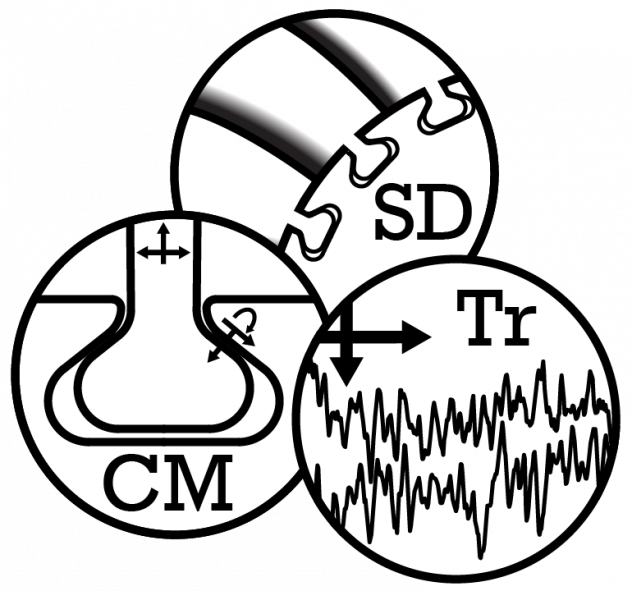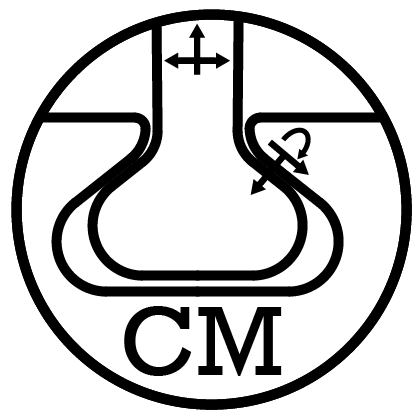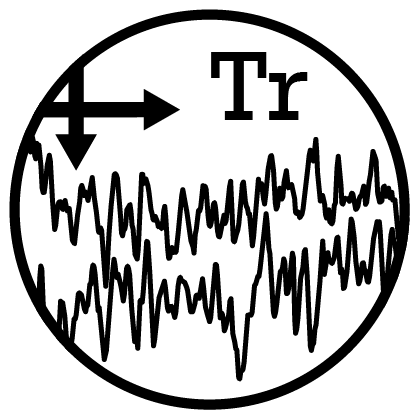What is Tribomechadynamics
 What is Tribomechadynamics? In short, it’s a new field that has emerged from the confluence of structural dynamics, contact mechanics, and tribology. Central to these three fields is the study of interfaces; the difference comes in the length scale considered and the tools used to study an interface. Given a structure, such as an aeroturbine, the goal of Tribomechadynamics is to predict the response of the structure during the design stage (including the full nonlinear response), to predict the performance degradation over time, and to use models to optimize the design of the interfacial components (in terms of weight, properties, wear rates, etc.). Thus, the research in the Tribomechadynamics Lab spans length scales from nano to macro.
What is Tribomechadynamics? In short, it’s a new field that has emerged from the confluence of structural dynamics, contact mechanics, and tribology. Central to these three fields is the study of interfaces; the difference comes in the length scale considered and the tools used to study an interface. Given a structure, such as an aeroturbine, the goal of Tribomechadynamics is to predict the response of the structure during the design stage (including the full nonlinear response), to predict the performance degradation over time, and to use models to optimize the design of the interfacial components (in terms of weight, properties, wear rates, etc.). Thus, the research in the Tribomechadynamics Lab spans length scales from nano to macro.
Structural Dynamics. At the macroscale, Tribomechadynamics is conce rned with the vibration and nonlinear dynamics of structures. Tools that this entail include reduced order modeling, nonlinear system identification, and simple, point-wise contact models that are usually heuristic in nature. Both reduced order models and high fidelity finite element models are used to understand the structural response of a system. In the lab’s logo, this is represented by the dynamic analysis of aeroturbine blades. As the system level response is sought, the assembly of multiple blades is considered, using a simplified contact model for each blade root-hub interaction. Typical experiments include impact hammers and shakers for excitation.
rned with the vibration and nonlinear dynamics of structures. Tools that this entail include reduced order modeling, nonlinear system identification, and simple, point-wise contact models that are usually heuristic in nature. Both reduced order models and high fidelity finite element models are used to understand the structural response of a system. In the lab’s logo, this is represented by the dynamic analysis of aeroturbine blades. As the system level response is sought, the assembly of multiple blades is considered, using a simplified contact model for each blade root-hub interaction. Typical experiments include impact hammers and shakers for excitation.
Contact M echanics. At the mesoscale, Tribomechadynamics is concerned with using the results of elasticity and plasticity analyses to understand the contact patch. This entails both static stress analysis and large, spatially distributed contact models that are usuallyl based on Coulomb friction. The goal of this mesoscale level of analysis is to both inform the structural dynamics analyses of what the contact patch (and resulting interfacial contact pressures) will look like, and to make informed calculations regarding the expected wear and fretting fatigue within a system. In the lab’s logo, this is represented by the turbine blade root-hub interaction, in which a dovetail joint is shown with some set of representative loads applied to both the far-field and the interface. Typical experiments include MTS machines for precise load-displacement controlled testing.
echanics. At the mesoscale, Tribomechadynamics is concerned with using the results of elasticity and plasticity analyses to understand the contact patch. This entails both static stress analysis and large, spatially distributed contact models that are usuallyl based on Coulomb friction. The goal of this mesoscale level of analysis is to both inform the structural dynamics analyses of what the contact patch (and resulting interfacial contact pressures) will look like, and to make informed calculations regarding the expected wear and fretting fatigue within a system. In the lab’s logo, this is represented by the turbine blade root-hub interaction, in which a dovetail joint is shown with some set of representative loads applied to both the far-field and the interface. Typical experiments include MTS machines for precise load-displacement controlled testing.
Tribology. The final constituent sub-discipline is concerned with the micro- and nano-scale analysis of the interaction of two surfaces. In particular, detailed models and experiments are used to either inform constitutive modeling  efforts or to study how wear over time will influence the energy dissipation characteristics of a surface. At this scale, contact models are usually formulated for asperity on asperity contact, though there is no such thing as a typical model as tribology spans many disciplines from solids to fluids to surface chemistry. In the lab’s logo, this is represented by two rough surfaces being pressed together with the same applied forces as seen in the contact mechanics-based logo. Typical experiments in the Tribomechadynamics Lab include profilometers, wear rigs, and, in our neighboring labs, tribometers and nano-indenters.
efforts or to study how wear over time will influence the energy dissipation characteristics of a surface. At this scale, contact models are usually formulated for asperity on asperity contact, though there is no such thing as a typical model as tribology spans many disciplines from solids to fluids to surface chemistry. In the lab’s logo, this is represented by two rough surfaces being pressed together with the same applied forces as seen in the contact mechanics-based logo. Typical experiments in the Tribomechadynamics Lab include profilometers, wear rigs, and, in our neighboring labs, tribometers and nano-indenters.
